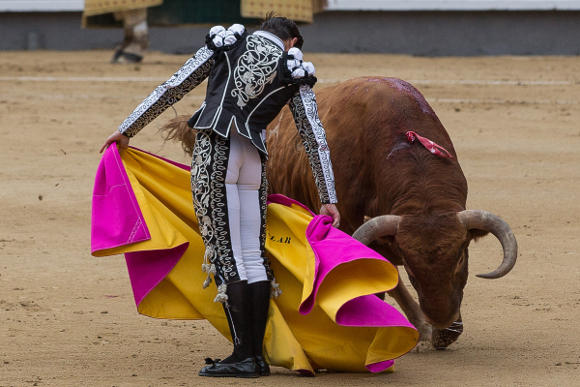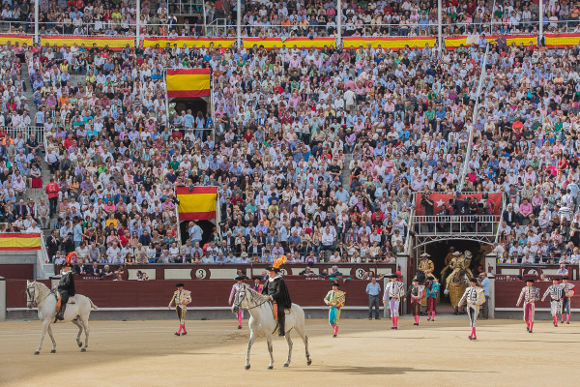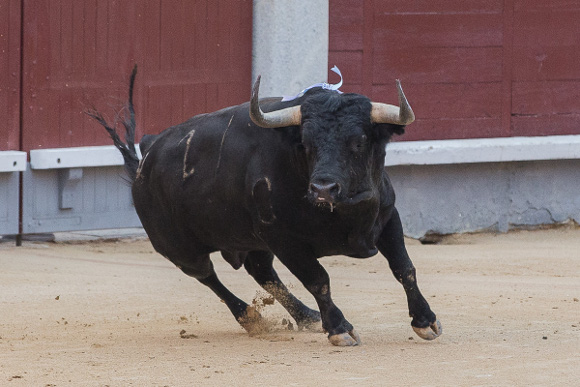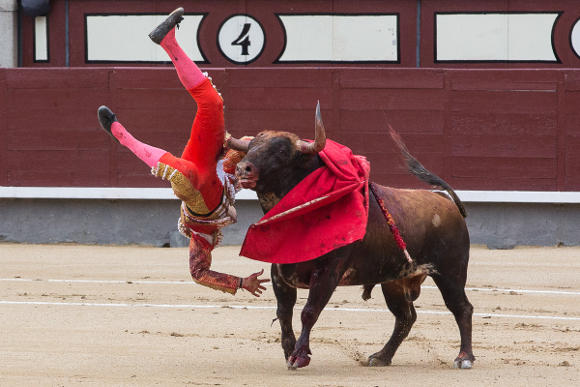Going to your first bullfight
Going to a bullfight for the first time can come with a mixture of emotions. Naturally for most people when choosing to experience a foreign spectacle with aspects which to they are not accustomed to as part of their own socio-cultural background there is a sense of apprehension as well as intrigue. That said, this is an event best attended with an open mind.
WHY DO PEOPLE GO TO BULLFIGHTS?
For the aficionados (lovers/fans) of bullfighting, going to a bullfight is to witness an event, which is powerful, artistic, sensory and dangerous. Though it is considered an art form, there is also a sporting character to the bullfight, as generally the aficionados will want to see which matadors perform the best, whether the breed of bulls is good or not, and quite simply, which matador will succeed most in understanding the bulls and risking his life to triumph on the sand, - the best outcome of a bullfight.

Alberto Aguilar performing a chicuelina pass with the capote in Madrid (photo by Andrew Moore)
As for foreigners, some choose to experience a bullfight out of curiosity, to witness a cultural spectacle, or to make up their mind for themselves about something that some deem a controversial topic. Some people leave a bullfight in disgust and others in awe and amazement of what they have seen. Others are indifferent. In this sense the response depends on the individual’s own taste, social and educational background, and their tolerance of other cultures, but it also depends largely upon the quality and level of bullfight attended. For a good first experience it is important to aim to see the top matadors in top bullrings. For more advice click here.
WHERE TO SEE A FIRST BULLFIGHT
While it is a complete fabrication of radical animal right activists that bullfighting solely survives as a tourist event, there are still bullfights put on with mainly this purpose in mind in some areas. This is particularly the case in some popular tourist regions in Mexico. By and large we would discourage choosing these kinds of events as a first bullfighting experience as the quality of the events offered is often extremely poor. The likelihood of experiencing an event of high quality and lasting impression is much higher when choosing to attend a bullfight in one of the major bullrings around the world. In Spain or France it would be advisable to attend one of the many major Ferias (festivals), which form the backbone of the European season. In Mexico we would recommend to see an event in one of the country’s major bullrings such as Mexico City, Aguascalientes, Guadalajara or others. For more information on some of the world’s major bullrings please click here.

Opening parade for a Corrida de Toros in Madrid's Las Ventas Bullring during its May San Isidro Feria (Photo by Andrew Moore)
WHAT EVENT TO CHOOSE
For people unfamiliar with taurine culture or for that matter the Spanish or French language there can often be considerable confusion about what type of event exactly one is buying tickets for. People often form opinions about “bullfighting” based on having unknowingly seen a different event than originally intended
In countries with bullfighting tradition you are likely to come across announcements for the following type of events:
Corrida de Toros
A Corrida de Toros is the highest ranking event within taurine culture and what is most commonly denominated as a “bullfight” by English-speaking people. A Corrida de Toros will feature fully licensed professional bullfighters who will perform with purpose-bred bulls that are between 4 and 5 years of age and usually weigh between 450kg and 700kg. To truly get an impression of bullfighting culture we recommend seeing a corrida in a larger bullring during a major feria/festival with a large crowd.

A fully grown fighting bull during a Corrida de Toros in Madrid (Photo by Andrew Moore)
Novillada con Picadores
A novillada con picadores follows the exact same structure as a corrida de toros but features bullfighters, usually younger in age, that have not yet achieved the official rank of “Matador de Toros”. The bulls in this event will be between 3-4 years old. Depending on the exact age of the bulls the size difference between these animals and the ones used in fully fledged corridas can either be gradual or very apparent. Going to a novillada can be an interesting experience as often, what the performers lack in polish and routine, they make up for in eagerness and willingness to make a name for themselves. A novillada in a big reputable ring with well-regarded and up and coming performers can be of equal or better quality to a good Corrida while on the other hand you are also more likely to see inexperienced performers struggling with controlling the animals.

A novillo bull fought in a Novillada with Picadors in Madrid in 2014 (Photo by Andrew Moore)
Novillada sin Picadores
A Novillada sin picadores follows the same structure as a corrida or a novillada con picadores with the exception that there will be no picadors acting in the event as bulls are not be picced as part of the proceedings. The bullfighters in these events are, with few exceptions, still very young, as are the bulls, which usually range from between 2 to 3 years old. Attending such an event, often but not exclusively held in smaller rings or towns, can be an interesting experience as they allow you to witness a hopeful youngster hone their craft, but they should not be measured with the same standards as a corrida or even a high level novillada con picadores. For the lack of a better analogy think of these events as the village high school drama performance to the corridas’ big city opera.

A smaller bull fought in a Novillado without picadors in a village north of Madrid ( Photo by Andrew Moore)
Becerrada
These events are often the first type of public exposure for young aspiring bullfighters. The toreros in these events are often very young and so are the animals which they are facing. Bulls in these events will generally be between 1-2 years old. Generally the structure of a becerrada follows that of a novillada sin picadores but in small towns events that are announced as Becerradas can often take different formats to what is generally understood as a becerrada by taurine professionals. Sometimes these events, while sold as becerradas will be more akin to exams, live classes put on by local bullfighting schools, often with young female animals that will not be killed.
Corrida de Rejones
A Corrida de Rejones is a professional bullfighting event featuring horseback bullfighters and fully grown fighting bulls (4-5 years old) often from ranches that specialize in providing bulls for such types of events. For most of these events, the horns of the bulls will be slightly blunted to avoid injuries to the horses involved. Horseback bullfighting or rejoneo is a very different discipline from bullfighting on foot. It aims at different artistic goals and tends to draw a slightly different crowd. Bullfighting and the equine world are highly intertwined in Spain, Portugal and parts of South America and Mexico and this is the event best reflecting this connection. We might add a separate section about rejoneo to this site down the line but for now Aficionados International focuses mainly on toreo on foot.

Rejonador Pablo Hermoso de Mendoza performing in the Bilbao Bullring (Photo by Andrew Moore)
Festival
A festival is what can be best described as a less formal bullfight. Events of this type often feature a mixture of different types of bullfighters (pro matadors, novilleros, becerristas, rejonadores) facing generally slightly less threatening and smaller animals. The goal of these events is often to primarily entertain and bullfighters will generally be in a less competitive mode at such event. Such events can be the taurine equivalent of jam sessions and be highly entertaining. They should not be confused with having witnessed a corrida however.
Festejos Populares
Across the taurine world there are literally hundreds of different popular festivals involving bulls. These can range from runnings of bulls, the French festival of course carmaguaise or other variants. Often such festivals are deeply rooted in local tradition. These festivals, while they can be highly entertaining have little to do what is general understood to be meant by the English term “bullfighting”. As a generalization they are generally not seen as artistic endeavors and with few exceptions do not involve the death of the bull/cow.
WHAT TO EXPECT
At a bullfight anything can happen and every bullfight is different in the sense that although there is a strict structure to the bullfight, the outcome is unpredictable. This is due to several variables:
-The nature and ‘quality’ of the bulls i.e. strength, endurance and willingness to charge.
-The matador’s level of skill and understanding – whether he can achieve fluid and engaging sequences of passes compatible with the bull’s character and nature and kill effectively.
-The crowd – the audience are highly influential in the outcome of a bullfight as they are the ones who judge the matador’s performance by waving their white handkerchiefs in approval and to persuade the ‘President’ or ‘Judge’ to award trophies.
-Weather conditions – strong winds make for extremely difficult conditions to perform in as the wind blows the bullfighters’ capes out of their control, sometimes making a sequence impossible.The chance of injuries and accidents.
-There is always a possibility of an injury. Sometimes due to the bull’s intelligence or level of aggression and sometimes due to the matador’s own mistakes or misjudgments.
Because of these variables, a bullfight may be exciting and successful, or it may be dull and poor. A poor bullfight is one where there bulls are weak and lose interest in charging, and/or a matador does not have sufficient experience or understanding of a difficult bull, or lacks in his skill, particularly with the sword. A matador who fails to dispatch the bull efficiently and therefore prolonging the death of the bull will be met with an unfriendly and critical crowd.
A successful bullfight is one where the bulls are strong, alert, active and ‘brave’ (willing to charge repeatedly without losing interest), allowing the matador to develop a varied and elegant performance as he passes the bull around his body in sequences which build to impressive finishing passes. The matador will be willing to create the most exciting performance possible for the audience and display both the bull’s qualities as well as his own. If the matador dispatches the bull effectively the audience celebrate and he may be awarded trophies.

Matador El Juli after a sucessfull performance (Photo by Andrew Moore)
For a more detailed description of the structure and stages of the bullfight see here.
Bullfights are attended by all age groups, women and men. In smaller provincial rings especially, it is common to see big parts of the municipalities’ population in attendance with families present with three to four generations. Big bullfights in Seville or Madrid for example on the other hand are much more a society affair and especially in the more expensive shady seats more reminiscent of a visit to the opera than to a village spectacle.
Many rings have a tradition of aficionados taking their own food and drink to the bullfight to share during the ‘merienda’ at the half way point of the bullfight.
THINGS YOU SHOULD KNOW BEFORE
At a bullfight you would see the wounding and killing of 6 bulls. (With the exception of Portugal and Quito, Ecuador where the bull is not killed publically in the ring, but instead is killed in private).
The bulls are wild animals bred specifically for the bullfight and have had minimal human contact in their lives. Read more about bulls here.

Matador Diego Urdiales killing a bull during a Corrida in Madrid (Photo by Andrew Moore)
Each bull is in the ring for 15-20 minutes. A bullfight featuring 6 bulls will last anywhere between two and three and a half hours or more, depending on if bulls need to be substituted, disruptions due to injuries and also how many laps of honor are granted to the Matadors and bulls performing in the event.
You may see the injury of a bullfighter. In this instance the bullfighter will receive immediate medical attention – in Spain the law requires that every bullring has medical facilities, usually an operating theatre within the bullring. While it is rare for a bullfighter to die in the ring, severe injuries do regularly occur. Often the sequence of a bullfighter being gored and subsequently carried off to the operating table happens very quickly and spectators only realize the severity of the injury due to reports after the event. Bullfighting history is full of many historic occasions where severely injured Matadors remained in the ring to finish their performance before proudly walking straight onto the operating table without assistance.

Matador Saúl Jiménez Fortes being gored by an El Ventorillo bull in Madrid 2014 (Photo by Andrew Moore)
Bulls can jump. Occasionally a bull will attempt to jump over the perimeter barrier of the ring as he explores his surroundings, but for a bull to reach the audience is extremely rare (so do not be put off by the videos you might have seen on the internet).
It is possible to leave the bullfight before it ends if you wish, but in most rings you cannot stand up and leave your seat while a bull is in the ring.
You should take a white handkerchief with you should you wish to join in and show your appreciation for a matador’s performance.
In all cases, to enhance your understanding and enjoyment of the bullfight, it is best to attend with a knowledgeable aficionado to explain the bullfight as it takes place.
BUYING AND CHOOSING TICKETS
These days most bullrings run a computerised ticket selling system and accept various types of credit cards, though a few bullrings still accept cash only.
Big events often sell out in advance however it might still be possible to get tickets off scalpers which will be swarming the ring during the day of the performance. 10% of tickets are reserved for release on the day of the bullfight by law (in Spain). On exceptional days these will be sold within minutes of the box office opening, however a majority of bullfights does not sell out. Often taken as a sign of declining popularity by detractors this is actually due to the fact that big performers and mid-level or upcoming Matadors all perform in the same ring. During a typical feria you will often see full or fairly full rings on days where big stars are announced and half full rings or less on days of novilladas or cards featuring lesser-known matadors. When choosing a ticket you have to make two decisions. Would you like to sit in the Sun or the Shade? And how close to the ring would you like to sit? These choices influence your experience and ticket price. Shade is more expensive than Sun, and the closer you are to the ring the more expensive your ticket. Shade is also where the palco the section containing the artistic judges will be located, causing the matadors to primarily perform in that part of the ring.

A ticket for a Corrida de Toros in Olivenza in Extremadura, Spain (Photo by Andrew Moore)
Sit wherever you think you will feel comfortable. Generally the first 10 rows feel close to the ring and allow you to see the bullfighter’s costumes and faces more clearly, as well as appreciate the bull at close range. If you want to be as close as possible, the front row will be listed at the ticket office as Barrera, and the second row as Contrabarrera, followed by Rows (Filas) 1 and onwards. But close is not always best. Many aficionados feel that the higher rows provide a better perspective of the whole ring rather than the shallow perspective of the front row.

A view of the bottom rows in the Madrid Las Ventas Bullring (Photo by Andrew Moore)
As for ticket price, bullrings vary. Seville is the most expensive bullring in Spain where you would pay 180 euros (approx.) for a front row seat in the shade, but this is expensive for a bullring and others are more reasonable. At Las Ventas in Madrid tickets range from 130 euros to 4 euros (approximately).
